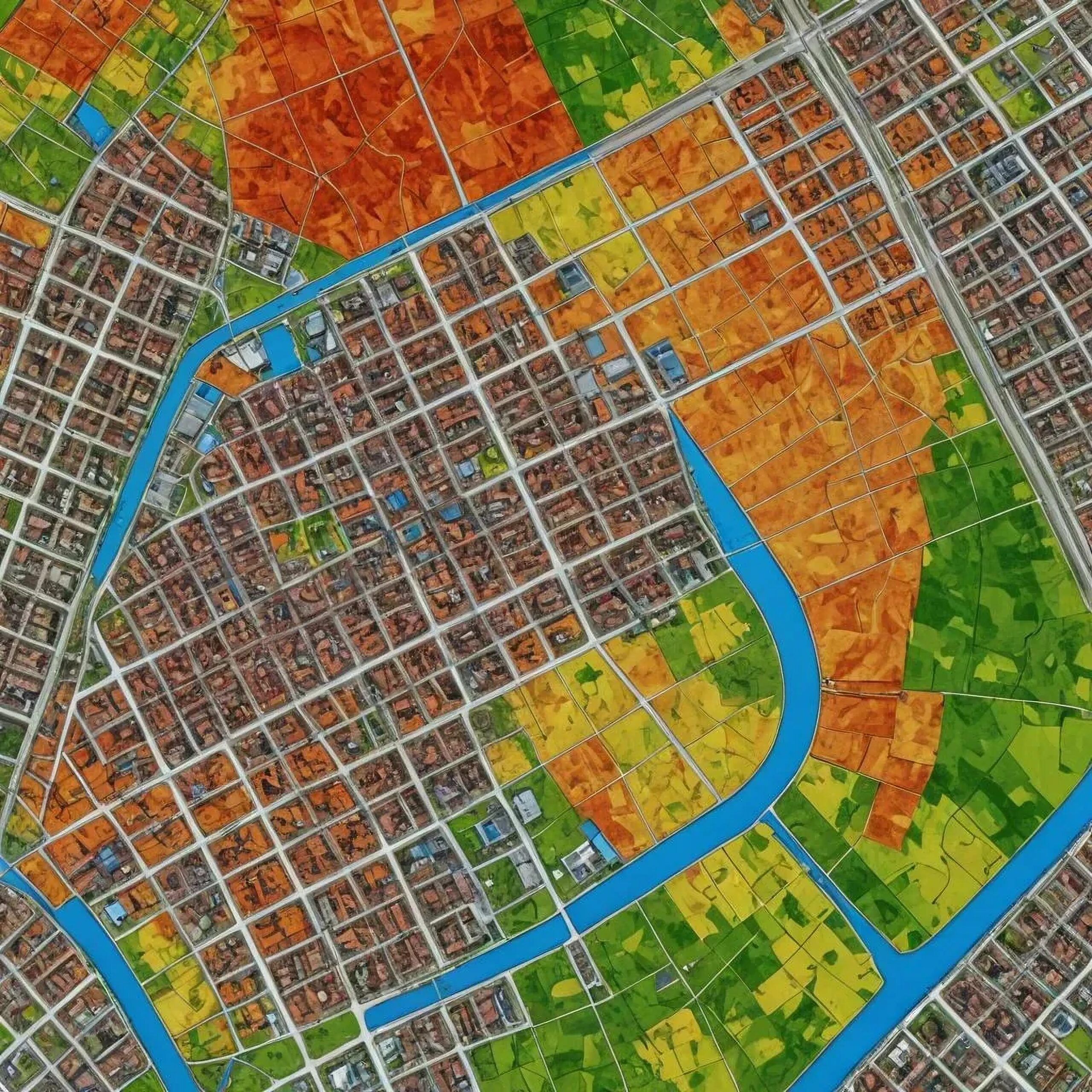HARNESSING THE POWER OF GIS IN PROPERTY VALUATION
Geographic Information Systems (GIS) can become indispensable tools in the field of property valuation, offering in valuable insights into spatial relationships,land use patterns, and market trends. By integrating geospatial data with traditional valuation methods, GIS can empower valuers to make more informed decisions, leading to accurate and defensible property assessments.
AUTHOR: AR. RITA MINHAS
Combining Geographical and Attribute Data
GIS is a powerful toolbox for valuers. It merges geographical data like maps and satellite images with attribute data, which includes various property details like size, age, and condition, as well as zoning rules and environmental conditions. This blend creates a comprehensive dataset that allows valuers to not only see where properties are located but also to dive deep into their specific characteristics and the surrounding environment.
With GIS, valuers can paint a vivid picture of each property within its spatial context. They can layer information on top of maps and images, revealing insights that might not be apparent when looking at data in isolation. For example, they could overlay property boundaries with zoning regulations to understand potential land use restrictions or examine satellite imagery to assess proximity to parks or water bodies.

By leveraging GIS, valuers can uncover hidden patterns and relationships that influence property value. They might discover that homes near schools or public transportation hubs tend to command higher prices, or that properties in certain environmental zones are more prone to flooding, affecting their desirability and value.
Comprehensive Neighborhood Analysis
One of the primary benefits of GIS in property valuation is its ability to provide a comprehensive view of the surrounding area. By overlaying property boundaries with demographic information,infrastructure maps, and amenities data, valuers gain a holistic understanding of the neighborhood,allowing them to assess factors such as accessibility,demand,and desirability.
Accessibility
GIS helps valuers analyze the proximity of a property to major transportation hubs,public services,and other key amenities, which can significantly impact its value
Neighborhood Demand
Integrating demographic data,such as population density,income levels, and house hold composition, allows valuers to assess the demand for properties in a given area.
Desirability
GIS enables valuers to identify factors that contribute to the desirability of a neighborhood,such as the quality of schools,the presence of parks and recreational facilities, and the overall a esthetic appeal.
Spatial Analysis and Market Trends
GIS isn’t just about visualizing data; it also enables sophisticated spatial analysis techniques that can significantly enhance the valuation process. Three key methods that GIS facilitates are spatial interpolation, hotspot analysis, and trend analyses.
Spatial interpolation involves estimating values for unknown locations based on known values at surrounding locations. In the context of property valuation, this means filling in the gaps between properties with available data. For example, if there’s data on property values for certain neighbourhoods but not for others, spatial interpolation can help estimate values for the missing areas based on nearby properties with known values. This technique provides valuers with a more comprehensive understanding of property values across a region, helping them make more accurate assessments.
Hotspot analysis, on the other hand, identifies clusters of high-value properties or areas experiencing significant growth. Using GIS, valuers can analyze spatial patterns in property values and identify hotspots where values are consistently high or where there’s a sudden surge in value. This information is invaluable for understanding market trends and predicting future property values. For instance, if GIS analysis reveals a cluster of high-value properties in a particular neighbourhood, valuers can investigate what factors contribute to their desirability and assess whether similar trends are likely to occur in neighbouring areas.
By merging historical data with spatial analysis in GIS, valuers can predict future property values and spot investment prospects. They analyze trends in property values over time and overlay data like demographics, land use, and infrastructure, identifying areas likely to grow or decline. This integration enables the development of predictive models, guiding strategic decisions on buying, selling, or developing real estate assets. GIS empowers valuers to anticipate market shifts and capitalize on opportunities in the real estate landscape.
By leveraging spatial analysis techniques like interpolation and hotspot analysis, GIS empowers valuers to gain deeper insights into market dynamics and make more accurate predictions about future property values. This enables them to stay ahead of market trends and provide valuable guidance to clients and stakeholders.

Assessing Environmental Risks
GIS serves a critical function in evaluating environmental risk factors that could influence property worth. By integrating information about flood zones, soil quality, and distance from hazardous sites, valuers can measure the possible risks linked to a property and modify their valuation accordingly. This ensures a thorough and informed estimation of value.
Environmental Risk Assessment
GIS enables valuers to identify and quantify potential environmental risks that could impact a property’s value,such as flood zones, soil composition, and proximity to hazardous sites.

Valuation Adjustments
By incorporating this risk data into their analyses,valuers can make informed adjustments to property valuations,ensuring a more informed Valuation insight.

Spatial Visualization
GIS provides a powerful visual platform for integrating and analyzing various types of geospatial data,allowing valuers to identify and communicate the impact of environmental factors on property values.

Transparency and Reproducibility
Further more,GIS enhances the transparency and reproducibility of the valuation process by providing a digital platform for data storage and analysis. Valuers can document their methodology, justify their assumptions, and visualize their findings in interactive maps and visualizations, making it easier to communicate their conclusions to clients and stakeholders.
Digital Documentation
GIS enables valuers to create a comprehensive digital record of their valuation process,including the data sources, analysis techniques, and assumptions used.
Visual Communication
Interactive maps and visualizations generated through GIS help valuers effectively communicate their findings, allowing clients and stakeholders to better understand the rationale behind the valuation.
Reproducibility
The digital nature of GIS-based valuations makes it easier for other professionals to review and validate the analysis,enhancing the overall transparency and credibility of the process.
Challenges and Adoption
Despite its numerous benefits, the adoption of GIS in property valuation is not without challenges. Access to high quality geospatial data, technical expertise in GIS software, and the integration of GIS into existing valuation work flows can pose barriers to entry for some practitioners.
Data Availability
Accessing comprehensive and up-to-date geospatial data can be a significant challenge, especially in areas with limited data infrastructure or resources
Technical Expertise
Effectively leveraging GIS in property valuation requires specialized skills and training, which can be a barrier for some valuers who may not have a background in geospatial analysis.
Integration
Seamlessly integrating GIS into existing valuation workflows and processes can be a complex and time-consuming task,requiring a significant investment of resources and effort.
The Future of GIS in Property Valuation
As technology advances and becomes increasingly accessible, the transformative potential of GIS in property valuation becomes increasingly evident. By leveraging GIS capabilities, valuers can gain access to novel insights, enhance precision, and provide enhanced value to their clients within the intricate and ever-changing real estate landscape. This technology enables valuers to delve deeper into property analysis, incorporating spatial data to understand complex market dynamics, identify emerging trends, and make more informed decisions. As a result, GIS not only enhances the accuracy of property valuation but also enriches the overall service offered to clients, ensuring they remain competitive in the ever-evolvingand complex real estate industry.
Improved Accuracy
GIS-powered valuation methods can lead to more accurate and defensible property assessments,enhancing the overall reliability and trust in the valuation process.
Deeper Insights
The rich geospatial data and analytical capabilities of GIS enable valuers to uncover previously hidden patterns and relationships that influence property value.
Increased Value
By leveraging GIS, valuers can provide more comprehensive and valuable insights to their clients, strengthening their position as trusted advisors in the real estate industry.
ABOUT THE AUTHOR

AR. RITA MINHAS
Graduation in Architecture, AIIA
Master of City Planning IIT KHARAGPUR
Registered Valuer (Land & Building)
IBBI Registration Number: IBBI/RV/10/2021/13874
CORE COMPETENCE & INDUSTRY-SPECIFIC EXPERIENCE
Residential and commercial Architecture, Earthquake Safe Technology Implementation in construction, Master Planning, MIS, GIS Mapping, Neighbourhood Planning, Affordable housing, Estimation & Budgeting. She has 15 years of experience in Residential Architecture and the real estate industry which has provided her good understanding of a variety of projects. She has been handling Valuation Assignments for Land & Building for various Banks as well as companies under Company Act.

